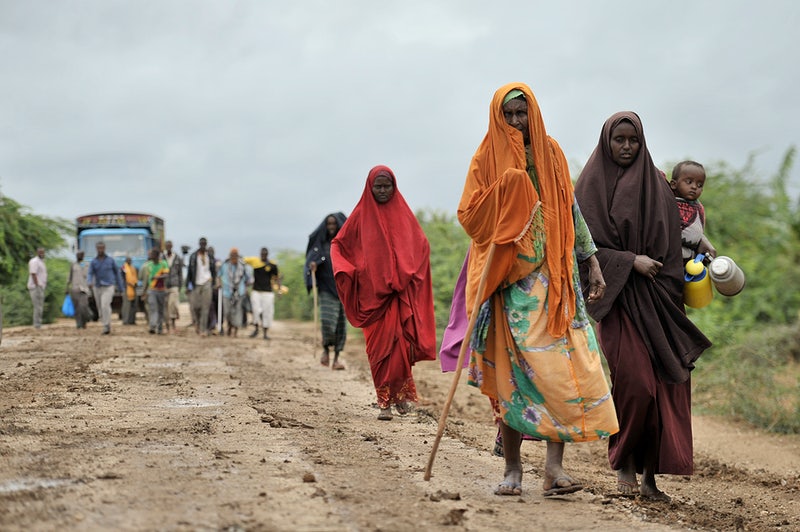
With millions of people at risk of starvation and ethnic violence, the international community and the world’s media continues to turn a blind eye to one of the world’s worst humanitarian catastrophes.
Over the last few months, we’ve heard daily reports about the unfolding conflict and humanitarian tragedy in Ukraine, with millions of people displaced and scores killed during the worst conflict to hit Europe this century. However, over the last couple of years another catastrophic conflict has received decidedly less attention: a civil war between the Ethiopian Central Government and an ethnic militia from the Northern Ethiopian state of Tigray known as the Tigrayan People’s Liberation Front (the TPLF). This conflict, largely ignored by the mainstream media, has not only led to the death and forced displacement of thousands of people, but also threatens to generate widespread instability in East Africa, by spilling over into the surrounding region.
To analyse current events we have to begin with the formation of the TPLF, which is a militia group mostly made up of ethnic Tigrayans, who total about 6% of Ethiopia’s population. This group dominated the Ethiopian People’s Revolutionary Democratic Front (EPRDF), a party, formed from a coalition of multiple ethnic militias, that governed Ethiopia following the fall of the ruthless Soviet-backed Derg regime in 1991. The post-1991 regime was a mixed bag to say the least, with successes such as dramatic economic growth and falling child mortality rates compromised by rigged elections, the imprisonment of political opponents and a prolonged border-war with Eritrea. By 2018, after protests followed another rigged election, the Amhara Democratic Party and Oromo Democratic Party (two ethnic parties represented in the EPRDF) rebelled against the Tigrayan sect of the coalition, by backing ethnic-Oromo politician Abiy Ahmed Ali to replace the incumbent Tigrayan-backed Hailemariam Desalegn as Prime Minister.
Abiy brought much needed reform to Ethiopia, including the freeing of political prisoners, the promise of democratic elections and a negotiated settlement to the conflict with Eritrea, for which Abiy received the Nobel Peace Prize. He also reformed the EPRDF coalition into the new “Prosperity Party”, which the TPLF refused to join, partly due to fears that Abiy would seek to replace Ethiopia’s ethno-federal system of governance with a unitary state. However, after the planned 2020 elections were postponed, supposedly due to Covid, Tigray held its own regional elections in spite of Government opposition, precipitating violence between the TPLF and Ethiopia’s Central Government, which soon accelerated into a full-on civil war.
Researchers from Ghent University claimed in a study published in March this year that this conflict has already seen the deaths of half a million people, due to the direct targeting of civilians, starvation and poor health care. These issues of famine and inadequate health care have been massively compounded by efforts by Abiy’s Government to block international aid from entering Tigray, a move that, whilst Abiy has blamed Tigrayan Forces, has led to an international outcry against the former Nobel Prize winner, with Abiy accused of starving his own citizens.
The conflict has already led to massive instability in the region, with the Abiy Government aided by forces from the TPLF’s long-time enemy Eritrea. According to William Davison from the International Crisis Group, the Ethiopian Government and Eritrean forces have been waging a targeted campaign against Tigrayan civilians to “break” their “spirit of resistance.” . Likewise, current tensions between the Ethiopian and the Egyptian and Sudanese governments over the construction of the Grand Ethiopian Renaissance Dam, which risks water shortages further down the Nile, are threatening to accelerate the conflict into a catastrophic internationalised dispute. In June this year, it was reported that violence had erupted in the disputed border region of Al-Fashaga between Ethiopian and Sudanese fighters, with this incident, along with joint-military exercises between the Sudanese and Egyptian Governments, reigniting fears about the internationalisation of the conflict.
As for the latest, the Ethiopian Government and their Eritrean allies in the north appear to be making huge advances towards the Tigrayan Capital Mekelle, with the recent capture of the city of Shire a huge victory for Abiy’s Forces. Meanwhile, the international community has called on the two sides to reach another ceasefire to allow crucial aid to be transported into Tigray, something Abiy, whilst supposedly supportive of negotiations, seems reluctant to abide by in practice, given the current momentum of the conflict. The latest round of peace talks were postponed just two weeks ago, with analysts sceptical of any further progress in the short term.
And so the war rages on, with millions more people at risk of acute malnutrition and ethnic violence. This risk of violence is not just limited to Tigrayan civilians – hundreds of Amhara civilians were massacred by Tigrayan youths in the town of Mai-Kadra in November 2020. Violence in recent weeks has exacerbated fears of ethnic cleansing by Ethiopian and Eritrean forces against Tigrayan civilians, in efforts to quell possibilities for future Tigrayan guerilla violence, with the WHO Director-General, Tedros Adhanom Ghebreyesus, himself an ethnic Tigrayan, recently statingthat “there is a very narrow window now to prevent genocide.”
And yet despite this, the world continues to turn a blind eye, with very little coverage of what is fast becoming one of the world’s worst humanitarian catastrophes. Whilst the Ukraine War continues to receive the coverage it rightfully deserves, the Tigray Crisis by comparison receives but snippets at best. For the sake of millions of Ethiopians, as well as the millions of people at risk from the surrounding countries, let us all hope that another ceasefire can be reached soon before this unfolding tragedy becomes even more tragic.
The neglect Tigray has seen from Western media, however, is not unique to Tirgray. To give an example, the Uyghur Muslim genocide in China received astounding media attention at first, yet nowadays coverage is relatively rare despite the lack of a resolution to the issue. A single person cannot solve issues in China, or Tigray, just as they cannot solve issues in Ukraine, but it is nonetheless tragic that those dying needlessly in regions outside the eye of the western media should die without a thought given to their suffering.



[…] the regional government in the northern state of Tigray. Though, the issue is of course much more complex. Throughout the last two years of conflict, amongst the many recorded atrocities from both […]